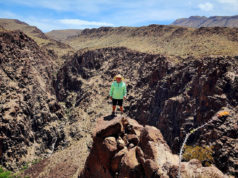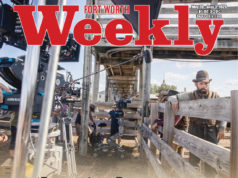The slight, unassuming woman, dressed all in black and seated at a table behind a laptop computer, coaxed wisps of feedback from an electric guitar lying flat in her lap, blending its tones with radio static and snippets of chatter in German and English. Berlin native Annette Krebs’ music at times seemed no louder than conversations in the basement-level bar. The volume level kicked up a notch when members of the group Zanzibar Snails joined in for an extemporaneous give-and-take.
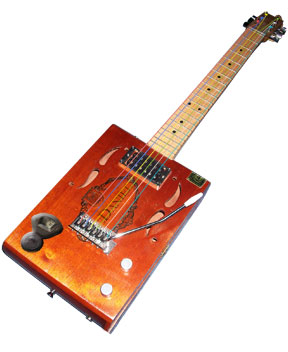 A few minutes later, it was Chris Cogburn’s turn. The Austin percussionist used cymbals and drumheads, but not in ways their manufacturers intended. He pulled a violin bow across the cymbal’s edge and scraped cymbals and beaters across drumheads rather than striking them. As he played, Zurich-based drummer Jason Kahn picked up the sound with his sound processors and altered it electronically, changing Cogburn’s organic sounds into static and sound waves. Then two more of the Snails joined in, on an electric violin and sine wave generator, for a cacophonous, free-form romp.
A few minutes later, it was Chris Cogburn’s turn. The Austin percussionist used cymbals and drumheads, but not in ways their manufacturers intended. He pulled a violin bow across the cymbal’s edge and scraped cymbals and beaters across drumheads rather than striking them. As he played, Zurich-based drummer Jason Kahn picked up the sound with his sound processors and altered it electronically, changing Cogburn’s organic sounds into static and sound waves. Then two more of the Snails joined in, on an electric violin and sine wave generator, for a cacophonous, free-form romp.
And all of this in the heart of Fort Worth’s boot-scootin’, line-dancin’ Stockyards. No Willie, no backbeat, no catchy choruses here. That cowboy buried on the lone prair-ee was probably spinning in his narrow grave.
“I didn’t realize Karlheinz Stockhausen was going to be in the house!” one wag remarked, no doubt enjoying the idea that, beyond the 40 or so fans gathered in the low-ceilinged confines of Lola’s Stockyards, few if any other people in the vicinity of Exchange Avenue and Main Street that night probably even knew who the visionary and controversial German composer was.
On that Tuesday evening last February at Lola’s, downstairs from the Star Café, the vibrations were atonal, minimalist, and electronic, and the musos were from all over the world. The No Idea Fest, an international celebration of musical improvisation begun by Cogburn six years earlier, had made its Panther City debut.
No Idea brought the shock of the “new” – though the genre’s been around for more than 40 years now – to the most visible bastion of Cowtown’s past. But it was really just the latest manifestation of something that’s been flying under the radar here for a while.
Fort Worth has been growing an experimental music scene, bit by bit, for a decade or so. Herb Levy, a well-known “new music” promoter in Boston and Seattle, has been presenting experimental artists of international stature in classy settings like the Modern Art Museum of Fort Worth since 2005. Last weekend, the Metrognome Collective reopened in a new space with the announced intention of providing a venue for experimental sounds. Fort Worth native Michael Chamy is creating some waves with the Zanzibar Snails, his noise/improv outfit, and his Mayrrh Records label. There’s even a house in Arlington that’s been putting on shows by local avant-gardistas.
Some of this music might ring a faint bell for listeners who’ve heard experimental musical influences in movie soundtracks and the work of ’60s rockers like the Beatles, Pink Floyd, and Frank Zappa or even Lou Reed’s Metal Machine Music.
But experimental sounds in their undiluted form also resonate for a younger generation who came of age with the entire history of recorded music accessible at the click of a mouse. The twentysomething rock ‘n’ roll kids at the Chat Room Pub have been exposed to frontier-pushing innovators from ’70s-era Miles Davis to prolific Japanese noise artist Masami Akita (who performs under the Germanic moniker Merzbow). Their ears are wide open, and there’s more to hear all the time.
The sounds heard at No Idea – which ranged from muted to bombastic, irritating to uplifting – had their genesis in the 1940s work of French recording engineer Pierre Schaeffer, who created the earliest examples of musique concrete from primitive samples he borrowed from sound-effects records using a disc-cutting lathe, playing them backward or at different speeds and juxtaposing them with other sounds to create a jarring sonic bath. By the ’50s, Stockhausen was electronically altering the sounds of voices and instruments and using the placement of musicians and loudspeakers in concert halls to create head-spinning effects. His later works included a string quartet for musicians flying in four separate helicopters.
At the same time, the American John Cage was writing pieces for the prepared piano – played with objects placed on its strings to alter its tonal quality – and instruments he fabricated from automotive detritus. Influenced by a study of Zen Buddhism, Cage used rolls of the dice to determine the sound, duration, volume, and tempo of events in his compositions. His piece 4’33” consisted of three movements during which the performer plays not a single note; the composer intended for his listeners to focus on the sounds of their environment.
These innovators’ forays into electronics, chance music, spatialization, drones, and the use of instruments in unconventional ways radically redefined what music could be. Or perhaps more accurately, what could be music: not just atonality but also everyday sounds, white noise, or even silence. Modern experimental music can encompass anything from soothing ambient drones to jarring, industrial-sounding “harsh noise.” It goes by the name of experimental or avant-garde or just “new music.”
New music enjoys its greatest popularity in Europe, Japan, and American cities like San Francisco and New York, where the Bang on a Can festival has presented performances and commissioned works since 1987. But there are festivals of experimental music in cities as unlikely as Boise, Idaho, and Athens, Ohio, and performers like percussionist Ikue Mori, harpist Zeena Parkins, and Texas-born accordionist Pauline Oliveros tour the U.S. frequently.
It’s taken awhile for an audience receptive to such sounds to develop here. As far back as 1982, Johnny Case was recording Remnants, an album of musique concrete sound collages that were unlikely to appeal to fans of his jazz piano stylings at Sardine’s Ristorante Italiano.
A few years later, Doug Ferguson started making home recordings of his own improvisations on old analog synthesizers and handing out the resulting cassettes to friends. In 1995, Ferguson got together with percussionist S. Forest Ward, bassist-drummer Nathan Brown, and clarinetist Chris Forrest to form Ohm, a band that achieved international status while remaining resolutely obscure at home. They played in venues ranging from rawk dumps to the sidewalk in front of the old Coffee Haus at 404 Houston St. in downtown Fort Worth.
Chamy, the Zanzibar Snails’ leader, remembers hearing Ohm at a party, where “they were set up in the four corners of the room. [Ward] was playing percussion, and [Brown] was playing a drum kit. The contrast between the synth and the organic instruments was really interesting. The room was carpeted, and by the end of the night everyone was lying in the middle of the floor.” Ferguson and Forrest both died in 2002; Ward recently resumed performing as a “one-man orchestra,” blending his drumming on beautiful self-constructed percussion rigs with samples and loops.
The Cowtown avant-garde scene got a shot in the arm in 2005, when Herb Levy, a native Bostonian and ardent new-music fan who spent the ’80s and ’90s promoting concerts, releasing records on his own label, and producing radio shows in Seattle, started booking performances of new music in the Fort, his home since 1999.
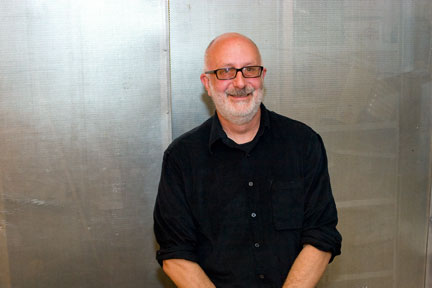 Levy plans to present five or six events in 2009 and 2010. It seems only fitting that a town that prides itself on its outstanding cultural outlets also offers opportunities to hear world-class contemporary creative music. Levy’s organization, called Other Arts, provides that.
Levy plans to present five or six events in 2009 and 2010. It seems only fitting that a town that prides itself on its outstanding cultural outlets also offers opportunities to hear world-class contemporary creative music. Levy’s organization, called Other Arts, provides that.
He prefers the term “new music” to “experimental” or “avant-garde,” he said, because “everyone I know has had a horrendous experience with something presented as experimental or avant-garde.”
Other Arts presents music by internationally known artists from outside the area who perform in a range of styles – including improvised, electronic, and chamber music – with the goal of “trying to get people to be more generally adventurous” and helping people who are already aware of some aspect of new music to understand what’s happening in other fields.
“I’m interested in people who are developing new musical languages that will become the new genres or styles of the future,” he said.
So far, Levy rates Ellen Fullman’s October 2007 performances on her 75-foot-long stringed instrument in a barn at Will Rogers Memorial Center as Other Arts’ greatest success. (Fullman drew 150 people over three shows.) Events such as composer Carl Stone’s digital treatments of sampled music and pianist Louis Goldstein’s performances of works by Cage and Morton Feldman drew smaller crowds, but he figures they were good crowds. The audiences included “an interesting mix of people who were [truly] interested in the music.”
It’s a mission that comes with some challenges, but Levy is encouraged by the response to events like No Idea. “There’s starting to be more of a critical mass of people who didn’t seem to be here when I first came to Fort Worth 10 years ago,” he said. “Some are new [listeners], and some have been changed by what they’ve heard.” Levy also sees a benefit in the opportunity the festival provided for the musicians to interact with “peers and colleagues who are working in the same areas.”
While Levy’s focus is on national and international artists, there are also local musicians working in the same areas. These artists rely mainly on word of mouth and social networking sites to spread awareness of one another’s activities and bring more listeners to shows. They may not be blazing totally uncharted trails, but they are finding in the music both a means of expression and a channel for connecting with like-minded others.
Around the time Levy was mounting his first production, Chamy and graphic artist/musician Nevada Hill began performing together in the Denton-based free-jazz/noise combo iDi*amin. That band released a CD on Chamy’s Mayrrh label (which he created to release his own work) and played a couple of gigs at the old Metrognome Collective spot on East Lancaster Avenue. In 2006, they brought in other musicians and became Zanzibar Snails, an amorphous unit that can range from two to half a dozen members. Besides Hill on guitar and electric violin and Chamy on electronics, the band has included vocalist Sarah Alexander, bassoonist Tara Wood, and electronics manipulator Mike Maxwell (all of whom performed at No Idea) as well as a score of others.
The group has released five albums, recorded in Chamy’s home or at live performances – four of them produced for Chamy’s Mayrrh label and one, Vanadium Dream, by L.A.-based Phantom Limb Recordings. Journey Into Amazing Caves, the most recent Zanzibar Snails offering, couples 53 minutes of new music with a DVD bearing a half-hour hallucinatory video montage by David Lee Price over a recording from a Snails live performance. Price’s video will be projected behind the band when they celebrate the album’s release at Good Records in Dallas on May 15.
In the last three years, Chamy and Hill have used their respective gifts to make sure their music “gets heard by the right ears,” as Chamy said. Chamy’s evocative words help promote the albums, and Hill designs album covers and posters. Last year, Zanzibar’s EP Krakkatowiak garnered a favorable review from underground tastemaker Byron Coley, writing in The Wire. Hill also designed the poster for the No Idea Festival.
Chamy grew up in Fort Worth. His first musical efforts came while he was earning a journalism degree from the University of Texas. “I’d plug a Casio keyboard into a couple of guitar pedals,” he said, “and try to make it drone like [Denton space-rock band] Comet.” In spring of 1996, he attended the first Melodica Festival, a three-day event held at the Argo in Denton, and had something of an epiphany. He became convinced, he said, that “anyone could do this stuff if you were in the right frame of mind. It’s all mind and ear.”
While covering music for the Austin Chronicle alternative newsweekly, Chamy was befriended and encouraged by local avant-gardist Rick Reed, who gave him some more sophisticated equipment. Now Chamy employs an arsenal of ancient analog tone generators and oscillators to create for others the the sounds he hears in his mind. But he was pragmatic enough to realize that he would have trouble making it as a muso in a town as dense with skilled players as Austin. When an opportunity presented itself to return to the 817 to manage rental properties for his father, Chamy jumped. Living in the Fort, he said, provides “the isolation you need to find your own inspiration.”
Mayrrh’s releases thus far include the iDi*amin disc, the four Zanzibar Snails CDs, two by Hill and Price, recording under the nom de disque D & N; and Age of Disinformation, an improvised performance led by Aaron Gonzalez, who also plays in the free-jazz band Yells at Eels. The label releases small runs – 100 or 200 – of homemade CDs, adorned with Hill’s screen-printed abstract designs. The label’s charter is simple, said Chamy: “To break even and get the music in the hands of people who will appreciate it.”

“Carbage Goma,” the live-recorded soundtrack to Amazing Caves‘ DVD, starts out with scraping and whirring machine sounds and muffled cries over a cavalcade of American cultural images made to appear sinister by the tension in the music. The visuals become kaleidoscopic as a mechanical pulse begins, the ensemble’s deep-space/underwater noises giving the listener a sense of disorientation. A mournful viola melody is followed by a chorus of electronically altered voices that combine with pixilated black-and-white images to create an atmosphere of ego-shattering isolation, giving way to bloodcurdling shrieks and a dissonant crescendo of sawing viola and feedback meltdown before grinding to a halt like a train pulling into a station. Price’s video inevitably begs comparison to the visuals Paul Baker used to project behind Denton dub-meisters Sub Oslo – which Zanzibar’s members would probably see as a compliment.
Experimental musos are habitual gear collectors, with a tendency to change things from show to show. For No Idea, for instance, Hill decided he was tired of playing guitar, so he made the gig on electric violin, an instrument he’d studied (in its acoustic version) as a child. But on the set, he employed it as a feedback generator as much as he exploited its melodic character.
With each principal bandmember having an array of instruments at his disposal and a range of potential collaborators, the possible sounds available to Zanzibar Snails are limitless. For folks who dig this racket, the way it develops – which is associative rather than linear, and thus more like the way human cognition and memory operate than the structure of a pop song or a sonata – opens up avenues of expression that allow for a totally different experience with each performance.
“When we first started collaborating,” Chamy said, Hill lived in Denton and was going to UNT, “and I’d always wanted a reason to hang out there, so we formed iDi*amin around a group of Denton musicians.” While Chamy now lives in Hurst and Hill in McKinney, both still consider Denton to be their “home-in-spirit.”
The last three years have seen an increase in creative music activity in some surprising corners of the 817. Arlington, for instance, is home to Steel Hook Prostheses, a band of ex-metalheads who play a dark, menacing brand of industrial noise. Then there’s the Wasted Words Collective, a trio of twentysomethings – Jason Aldy, Justin Robbins, and Ryan Tally, also from Arlington – who’ve been putting on shows at their house since last fall.
The Wasted Words crew was inspired to make their house a venue by the example of Denton’s “House of Tinnitus.” You won’t find it on any list of bars and clubs – it’s also known as the home of Amelia Jaycen and Rob Buttrum, who’ve been hosting noise and improv shows there since 2006.
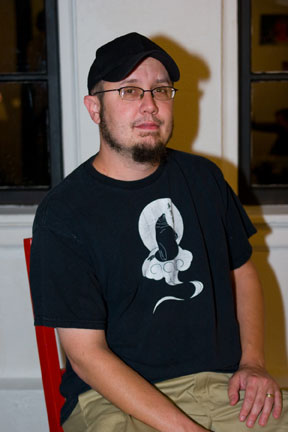 “There’s an empty house next door, and our other neighbors are really cool,” said Aldy, who’s been a noise fan since age 14 (he’s 28 now). He and Tally became friends while playing noise at house shows and 1919 Hemphill in bands with names like Judascow and Unprotected Sex. He never thought to look for venues in his hometown, Aldy said. “We figured there was nothing happening in Arlington as far as experimental music or weird art.”
“There’s an empty house next door, and our other neighbors are really cool,” said Aldy, who’s been a noise fan since age 14 (he’s 28 now). He and Tally became friends while playing noise at house shows and 1919 Hemphill in bands with names like Judascow and Unprotected Sex. He never thought to look for venues in his hometown, Aldy said. “We figured there was nothing happening in Arlington as far as experimental music or weird art.”
So far, the crowds at Wasted Words’ shows have been averaging 30 people, ranging in age from 18 to mid-30s, one Saturday a month. Their focus has expanded, however, as out-of-town bands have contacted them via MySpace. Aldy has also met “weird artists” through his day job at the Arlington record store Entertainmart. The trio plans to start booking other bands twice a month starting this summer, as well as publishing a fanzine-with-CD. “We express ourselves in any art away from the norm – music, paint, poetry, found arts,” said Aldy.
Another experimental music band playing in Denton is Dirty Water Disease, a project of Brent Frishman and Michael Briggs, two friends from Carrollton. They began promoting shows in Denton in 2006 and have released recordings under the umbrella of Gutterth Productions.
The experimental music community is small enough that most of its members have shared stages, played in each other’s bands, promoted each other’s shows, and played a part in the release of other bands’ recordings. You don’t need six degrees of separation to get just about everyone into the circle.
The Wasted Words guys, for instance, count Michael Chamy and the House of Tinnitus hosts among their friends. And Dirty Water Disease has often shared a stage with Terry Horn’s various projects. Horn, a local musician and visual artist, also provides a link to the newest experimental music venue about to launch in these parts – the Metrognome Collective, moving into a new East Fort Worth home with a pledge of a new emphasis on creative music.
Terry Horn is as low-key and self-effacing in person (he says he‘s both lazy and ADD-afflicted) as Chamy is brash and extroverted, though both are passionate about their music.
Today Horn lives where the eastern end of Fort Worth butts up against Arlington, but he grew up in Montgomery, Ala., playing bass in punk and metal bands. “I was improvising back then, though,” he said, “because my ear training wasn’t good, and I wouldn’t take the time to learn a song off a record.” He played in the jazz band at his arts magnet high school, studied with the bassist from the Maxwellaires, the military band from Maxwell Air Force Base, and learned from local bluesmen and “lots of country people.”
At the University of Alabama, Horn majored in studio art with a minor in music theory. He brings a visual artist’s sensibility to his musical projects, although he’s surprisingly uninterested in combining the two: “I think the music is interesting enough to stand by itself,” he said.
He got his first exposure to experimental music through an instructor who was a glassblower and played recordings by the British free improvisers AMM and avant-garde composers for his classes. Horn started building cigar-box guitars and other stringed instruments, inspired by the eccentric composer, hobo, and instrument-builder Harry Partch.
In 1998, after graduation, Horn and his wife moved to the Metroplex. By that time, Horn’s interest in experimental music had grown. A few years later he met Mark Cook, a progressive rock musician who uses a two-handed tapping technique on his 14-string Warr guitar to produce as much music as a bassist and a guitarist would create simultaneously. In 2002, the two began hosting a monthly improvised music event under the rubric Improvised Silence (later Implied Silence) at Lori Thomson’s Firehouse Gallery on Meadowbrook Drive.
“Homeless people in the neighborhood would come by because they knew if they knocked on Lori’s door, she’d give them something,” Horn said. “Whenever I had a show, I’d let the homeless guys help with the equipment and give them whatever food and drink I had left over.”
At the Firehouse, Horn performed on instruments ranging from prepared “tabletop” guitar (a style pioneered by AMM’s Keith Rowe, another musician with a visual art background) to his own homemade creations to turntables and tape recorders, performing solo and in groups with musicians including Cook, Gutterth’s Briggs, and Ryan Supak. He presented improvisational artists from places like Austin and Houston. But attendance was nearly nonexistent. “After awhile, I realized that if you called it ‘avant-garde’ or ‘experimental,’ you’d scare people off,” he said. “If you called it ‘improvisation,’ you’d get people who expected jazz. When they walked in and saw my laptop, my turntables, and my cassette player, they’d leave in a hurry.”
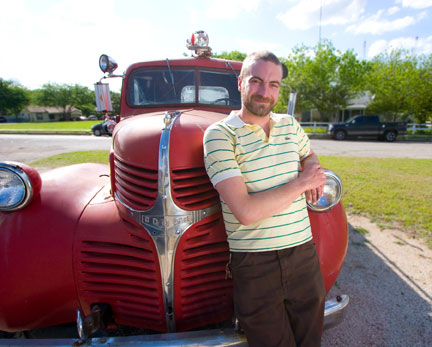 Horn wasn’t discouraged, however. “People in Dallas and Fort Worth seem to think that it’s pointless to play music if you’re not going to make a lot of money,” he said, but he sees it as its own reward. “I play every day. I don’t have enough money to buy a lot of music, so I have to make the music I want to hear.”
Horn wasn’t discouraged, however. “People in Dallas and Fort Worth seem to think that it’s pointless to play music if you’re not going to make a lot of money,” he said, but he sees it as its own reward. “I play every day. I don’t have enough money to buy a lot of music, so I have to make the music I want to hear.”
He and Thomson were running another gallery on East Lancaster Avenue when James Watkins came by looking for a home for his Metrognome Collective. They agreed to sublet him their space and gave him some cautionary advice. “When James went downtown to get the permits [for Metrognome], we warned him not to tell them what he was using the space for, but he did anyway, because he said that not to tell them would be dishonest.” The fire marshal shut down the building for code violations just before Christmas 2006.
A lot of folks might have written off the collective after that, but the Metrognome is living proof of the truism that arts communities are harder to kill off than cockroaches. After losing their original space, the Metrognome survived by performing “guerilla actions” such as the art show they held in a U-Haul trailer parked outside the Chat Room during the South Side’s Arts Goggle. But their lack of a physical location precluded any musical presentations.
As summer of 2008 turned to fall, Watkins grew weary of the long, grueling work weeks that come with running a nonprofit arts organization with volunteer labor. He decamped for Eugene, Ore., to learn about sustainable farming, leaving the Metrognome in the hands of Ben Rogers, another obsessive-compulsive workaholic and passionate arts advocate who earned his spurs as production manager for the Chat Room and on the road with the Polyphonic Spree. The collective, before Watkins left, became part of the Mission Co-Op nonprofit. The Co-Op also includes a couple of other Rogers brainchildren: One Hundred Second Dash, a web site that makes compilations of local music available via free download, and the Real Vinyl label, which will release works by local artists.
“I’ve fished on commercial boats in four different oceans and climbed radio towers on four continents,” said Rogers on a March evening when the Chat Room was presenting a one-off noise show with the bands Psychedelic Horseshit, Drug Mountain, and Fungi Girls. “But I can never stay away from Fort Worth for more than eight or nine months. It’s my favorite city on earth.”
Firehouse Gallery closed its doors for the last time a week after the No Idea Festival. On April 1, Thomson handed the keys (and the torch for extreme left-of-center sounds in the Fort) to Rogers, who had taken over leadership of the collective last September. Rogers intends to make it a showplace for avant-garde and experimental music, he said, “because that’s the one kind of music [for which] there isn’t currently a regular outlet in Fort Worth.” But he opted to keep the Firehouse name to maintain a link with the work Thomson had done there. On April 19, the Metrognome reopened the Firehouse doors with an exhibit of paintings by F6 Gallery co-organizer Jeru Gabriel and music by Yells at Eels and Houston improvisers Dave Dove, Sonia Flores, and Jason Jackson.
Before moving into the Firehouse building, Rogers worked diligently to foster connections with neighborhood associations, schools, and churches in the Meadowbrook area. “A lot of what we’re planning to present, while I wouldn’t classify it as ‘adult content,’ isn’t going to be to everybody’s taste,” Rogers said. “We want to make sure that for every show we promote, we do something to give back to the community.” His goal is to make the Firehouse the same kind of neighborhood hub for Meadowbrook that the Chat Room is for the Fairmount neighborhood.
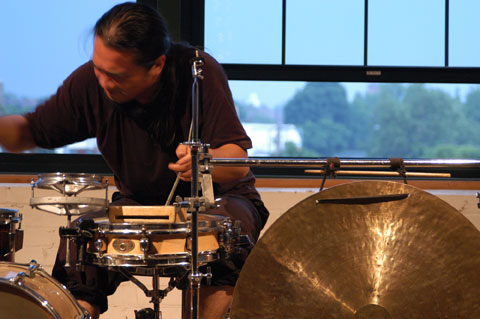 Show times at the Firehouse will be earlier than club shows typically start – at 8 p.m. rather than 10 p.m. Art exhibits will hang for a month in the Firehouse’s Studio and Garage galleries, with a new exhibition kicking off in one of the spaces every two weeks. Rogers plans to have live music on the exhibits’ opening nights. He’s working on a schedule and thus far has confirmed only one show, on May 15, featuring New Zealand psychedelic duo Metal Rouge, “ambient-folk” Oklahomans Anvil Salute, a Chamy-less version of Zanzibar Snails, and Shortwave Death System, a solo artist from Dakota, Texas, who performs on shortwave radios. Updates to the Firehouse calendar will be accessible online at www.metrognome.org.
Show times at the Firehouse will be earlier than club shows typically start – at 8 p.m. rather than 10 p.m. Art exhibits will hang for a month in the Firehouse’s Studio and Garage galleries, with a new exhibition kicking off in one of the spaces every two weeks. Rogers plans to have live music on the exhibits’ opening nights. He’s working on a schedule and thus far has confirmed only one show, on May 15, featuring New Zealand psychedelic duo Metal Rouge, “ambient-folk” Oklahomans Anvil Salute, a Chamy-less version of Zanzibar Snails, and Shortwave Death System, a solo artist from Dakota, Texas, who performs on shortwave radios. Updates to the Firehouse calendar will be accessible online at www.metrognome.org.
Part of the challenge Rogers faces will be pulling together the diverse strands of Cowtown’s arts-supporting community – the kids who go to shows at the Chat Room, the folks who go to art openings, and those who subscribe to the symphony and museums – and getting them out to the East Side. He plans to start slowly, booking a couple of shows a month, “but if an out-of-town band contacts us wanting a show, I wouldn’t turn them down.
“I’m working 95 hours a week for no pay, but I’m not doing all the work myself,” he said. “I’m looking for people who can take this over when I’m done” – he’s amended the organization’s bylaws to limit the director’s term to five years – “and when it comes to the arts, it’s important to constantly have fresh blood and new ideas.”
Back at Lola’s Stockyards, Tatsuya Nakatani, a Japanese percussionist who now lives in Pennsylvania, took a more kinetic and visceral approach to the same techniques that Cogburn had employed earlier in the evening. Nakatani joined Dallas-based trumpeter Dennis Gonzalez and his sons Aaron (bass) and Stefan (drums), who are also the trumpeter’s bandmates in Yells at Eels. The result was a whirlwind set marked by explosive energy and abandon. The Gonzalez clan’s participation in No Idea came after Aaron met Cogburn at an improvisational music event they played in Merida, Mexico, in June.
The No Idea festival’s modest audience was more impressive than it looked, considering that a last-minute venue change had shifted the show from Lola’s 6th Street location to the Stockyards. The turnout wasn’t enough to put the event in the black, but the performers seemed oblivious to such considerations. They played on into the night, as cowboy-seeking tourists wandered by outside, and boot-scooters two-stepped in clubs all around them.




